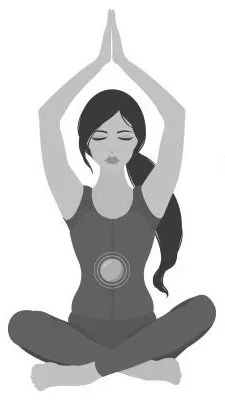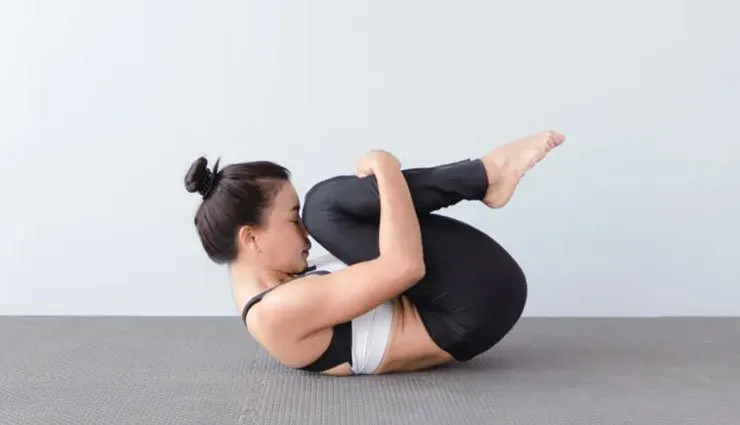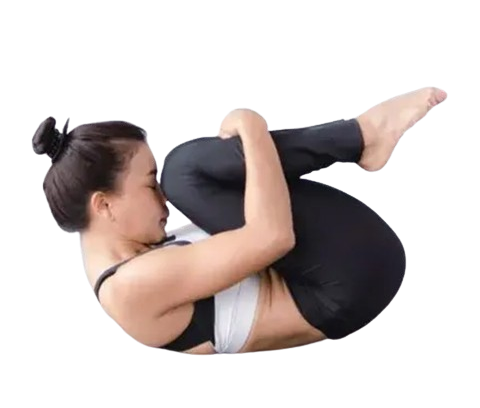On This Page
Different Yoga modules that can be used as remedial therapy to better manage the symptoms of Ulcerative colitis are as follows:
- Regulation of Manipura Chakra
- Dhouti Karma, Nauli Karma, Kapalbhati (Shodhana Karma)
- Yoga module that particular focus on the abdominal region and helps to relieve Ulcerative colitis
- Specific Asana for Ulcerative colitis
- Mudra
Regulation of Manipura Chakra
Manipura Chakra is correlated with the coeliac plexus and small plexuses surrounding it. Manipura Chakra lies in the vicinity of Nabhi (umbilicus). In the vicinity of Nabhi, the coeliac plexus is the most prominent major autonomic plexus that surrounds the coeliac artery and the root of the superior mesenteric artery. According to classical texts of Yoga and Ayurveda, Manipura Chakra is the Sthana (seat) of Samana Vayu which helps in regulating the proper distribution of food, drink, blood, and inhaled material in the body. By regulating Manipura Chakra motility of the Gastrointestinal tract is balanced by regularizing the contraction and relaxation of intestinal muscle fibers. From this, we can conclude regulation of Manipura Chakra affects the physiology and pathology like Ulcerative colitis of abdominal organs. Regulation of Manipura Chakra produces both physical and psychological effects.
To Know more about Manipura Chakra, Click here.

Shodhana Karma (Ghata Shuddhi – Purification of body)
Shodhana means the cleansing process or purification process. It is popularly known as Shat Karma or Shodhana Karma in Gheranda Samhita and Hath Yoga Pardipika. Shat Karma is a set of six cleaning practices that helps to cleanse the important areas of the human body. It is done before other procedures like Asana, Mudra, etc. Shodhana Karma is described in Hath Yoga Pardipika as an optional Karma and also it was not mentioned under the limbs of Hatha Yoga. While in Gheranda Samhita, Shodhana Karma is one of the seven limbs of Ghata Yoga (Sapta Shadhnam). In Gheranda Samhita, Shodhana Karma (Nirmanu Nadi Shodhana) is considered the Method of Nadi Shodhana (G. S. V/ 36, 37).
Note:- Expert advice is necessary before doing any Karma (procedure).
To Know more about the Regulation of Shata Karma or Shodhana Karma, Click here.
Shodhana Karma Beneficial in Ulcerative Colitis
1. Dhoti Karma
This cleansing Karma is used to train the mind and body for voluntary control over the anti-peristaltic or peristaltic movement of the digestive system. Dhoti Karma helps in the cleansing of the stomach and digestive tract.
Benefits of Vata Sara Dhouti Karma in Ulcerative colitis
This cleansing procedure helps increase digestive capacity, and enhance metabolism. Thus, helping to cure various symptoms related to IBD i.e., Ulcerative colitis and Crohn’s disease.
Benefits in Vahni Sara Dhouti Karma in IBD (Ulcerative colitis)
- Deeply massage the abdominal organs
- Strengthen the abdominal muscles
- Reduce abdominal fat
- Simulate the nerve supply related to the digestive system
- Increase the capacity to digest the food
- Promotes proper utilization of nutrients by allowing maximum assimilation, and balanced secretion of digestive juices.
- Beneficial to counteract all the symptoms related to IBD like indigestion, abdominal pain, constipation, diarrhea, etc.
To Know more about Dhoti Karma, Click here.
2. Nauli Kriya
Nauli Karma or Nauli Kriya or Laukik Kriya is one of the Shat Karma (the yogic procedure done for cleansing of the body), which is a kind of abdominal massage which provides exercise to abdominal viscera and abdominal muscles. Nauli is derived from two words Nau means boat and li means ‘to adhere to or ‘to grasp’. Therefore, Nauli is the procedure in which Sadhaka (practitioner) make their body tubular shape in the middle of the abdomen, by bending forward and pushing the abdomen backward, In this procedure, abdominal organs movement is done transversally and vertically like the waves (Lehar) movement. Nauli Kriya is mentioned as Laukiki Kriya in Gheranda Samhita.
To Know more about Nauli Karma, Click here.
3. Kapala Bhati
Kapala Bhati is one of the Shat Karma and is a powerful breathing technique that helps to remove toxins (Ama) from the body. It stimulates the abdominal organs and helps to relieve various symptoms related to GIT disorders like constipation, acidity, indigestion, etc.
To Know more about Kapalabhati, Click here.
Yoga Module that Particular Focus on the Abdominal Region
Stage 1: Start affirmation: Produce the OM sound three times and A- U- M sound three times.
Stage 2: Different breathing practices can be done like:
- Bhujangasana (moon pose breathing)
- Vyaghra Asana (tiger pose breathing)
- Padottanasana (straight leg raise breathing)
Stage 3: Instant relaxation should be done by Shava Asana.
Stage 4: Sthilikaran Vyayama should be done after instant relaxation like twisting, side bending, forward and backward bending, etc.
After this Pawan Mukta Asana should be done.
Stage 5: Instant relaxation should be done by Shava Asana.
Stage 6: Different Asana should be done in sitting, standing, supine and prone position to focus on an abdominal region like:
- Ardha Chakra Asana (half wheel pose)
- Ardha Kati Chakra Asana (half waist wheel pose)
- Trikonasana (triangle pose)
- Vriksha Asana (tree pose)
- Padahastasana (hand to feet pose)
- Paschim Uttana Asana (seating forward bend pose)
- Bhujangasana (cobra pose)
- Matsyasana (Fish pose)
- Sarvanga Asana (shoulder stand)
These asanas can be done gradually.
Stage 7: Instant relaxation should be done by Shava Asana.
Stage 8: Pranayama and Kriya (regulated breathing and cleansing)
- Bhastrika Pranayama
- Sheetali Pranayama
- Sheetkari Pranayama
- Bhramari Pranayama
- Uddiyana Bandha
- Kapala Bhati
Stage 9: Meditation (Dhyana) should be done like OM sound meditation.
Stage 10: Closing affirmation: Produce the OM sound three times and A- U- M sound three times.
Specific Asana for Ulcerative Colitis
1. Bhujangasana
Bhujangasana also known as Cobra stretch Asana. In Hath Yoga and modern Yoga, this Asana is mentioned under reclining back bending Asana. This Asana represents the position of the cobra when it is most aware and alert about its surroundings. This Asana is also done under Surya Namaskar in steps 8 and step 20. This Asana stimulates abdominal organs, soothes sciatica, tones the buttocks, strengthens the spines, etc.
Mechanism of action and benefits in Ulcerative colitis
This Asana affects abdominal muscles and abdominal organs. Bhujanga massage provides proper massage to the abdominal organs and increases the flexibility of the back. This Asana helps to remove flatulence after taking meals. Along with this, it is very beneficial in treating various Gastrointestinal symptoms like constipation, indigestion, low digestive fire, etc.
To Know more about Bhujangasana, Click here.
2. Paschimottanasana
The Paschimottanasana word is derived from Paschima meaning posterior or back or west and the word Uttana means to stretch that’s why this Asana is known as ‘The back stretching pose’. Paschimottanasana evenly and intensely stretches the calf muscles. This Asana has various health benefits and is very famous for increasing height. It Is very good for growing children. If you are suffering from Tamaka Shwasa (Asthma) then avoid this, Asana.
Mechanism of action and benefits in Ulcerative colitis
Paschimottanasana tones and stretches the spinal and hamstring muscles and the associated nerves. This Asana improves the efficacy of the spinal nerves, in particular, therefore Paschimottanasana has beneficial repercussions throughout the entire body. It helps to remove excess abdominal fat and increases digestive fire, flatulence, constipation, anorexia, etc. Thus, it is very beneficial in treating Ulcerative colitis.
3. Mudra
Mudra Benefits for Ulcerative colitis are as follows:
- Maha Mudra
- Kaki Mudra
- Bhujangini Mudra
- Vipareeta Karani Mudra
- Pashinee Mudra
- Apana Vayu Mudra
- Apana Mudra

Have A Health Issue?
Consult Online
- Dr. Sahil Gupta (B.A.M.S., M.H.A.)
Ayurvedic Allergy Specialist
CEO & Founder of IAFA®
Yoga Module to Relieve Ulcerative colitis

References
- Jan K. Brzezinski, Yoga Trangini, A rare commentary on Goraksha Samhita, Published by Himalayan Yoga publication trust, First edition, Delhi, 2015.
- B. K. S. Iyengar, Light on Pranayama.
- Swami Dwarika Nath Shastri, Hath Yoga Pradipika, reprint 2009, Chaukambha Vidya Bhavan.
- Acharya Shri Nivasa Sharma, Gherand Samhita, first edition 2006, Choukambha Vidya Bhavan.
- Kasper, Braunwald, Fauci, Hauser, Longo, Jameson. HARRISON’S PRINCIPLES OF INTERNAL MEDICINE, Volume II, 16th Edition page 1789, Mc Graw Hill.









